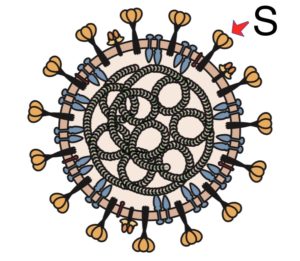

Small animal models (mice, ferrets, hamsters) are essential for understanding how SARS-CoV-2 causes disease and for pre-clinical evaluation of vaccines and antiviral therapeutics. One promising model has been developed by modifying SARS-CoV-2 so that it binds to murine ACE2.
Laboratory mice cannot be infected with SARS-CoV-2 because the viral spike glycoprotein (illustrated) does not bind to murine ACE2, the ortholog of the human receptor. Mice transgenic for the human ACE2 gene, produced after the SARS-CoV outbreak, can be infected with SARS-CoV-2, but the pathogenesis does not resemble that observed in humans. For example, mortality in infected mice appears to be a consequence of replication in the central nervous system, not in the respiratory tract. The altered pathogenesis might be due to improper expression patterns of the ACE2 gene.
In another approach to producing a mouse model for COVID-19, the spike glycoprotein of SARS-CoV-2 was modified so that it efficiently binds murine ACE2 protein. Only two amino acid changes in the S protein were required to allow infection of cells that produce murine ACE2 without affecting reproduction in monkey cells.
Upon intranasal infection of young mice, virus replication was detected in the upper and lower airways and was accompanied by mild to moderate disease. In contrast, after inoculation of older mice, viral replication was not only detected in the upper and lower tract but was associated with lung inflammation and loss of pulmonary function. The age-dependency of disease mimics what is observed in humans.
As a proof of principle, the mouse model was used to evaluate efficacy of a vaccine and antiviral. After vaccination of mice with a Venezuelan equine encephalitis vector carrying the SARS-CoV-2 spike protein gene, reduced virus replication in lung and upper respiratory tract was observed after challenge compared with control mice. Furthermore, prophylactic and therapeutic administration of IFN-lambda-1 reduced virus titers in the lung compared with untreated mice.
This mouse model is attractive because it does not require the development of genetically altered animals. However it is not a perfect model because there are likely differences in tissue distribution of ACE2 in mice and humans which could affect disease outcomes. Whether this difference has an impact on the usefulness of the mouse model remains to be seen. Meanwhile other mouse models are being developed which might have other advantages: for example the production of human ACE2 in mice by using adenovirus-associated virus vectors.

Pingback: A mouse model for COVID-19 – My Main Thing | Weedmain.com
Pingback: A mouse model for COVID-19 – Virology Hub
“Thank you for sharing such great information.
It has help me in finding out more detail about post-exposure prophylaxis for COVID-19“